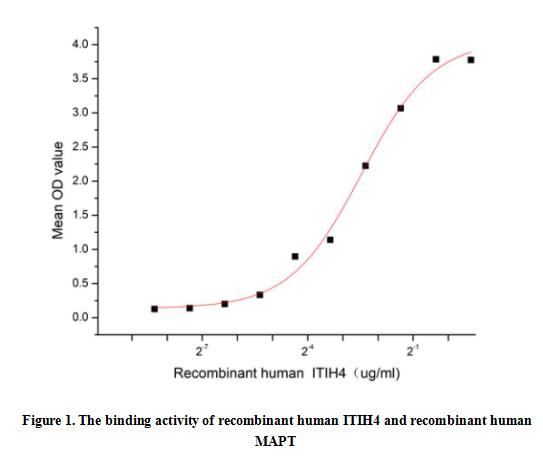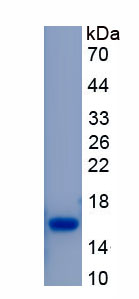Active Inter Alpha-Globulin Inhibitor H4 (ITIH4) 

IHRP; PK120; H4P; ITIHL1; Plasma Kallikrein-Sensitive Glycoprotein; Plasma kallikrein sensitive glycoprotein 120; Inter-alpha-trypsin inhibitor family heavy chain-related protein
- UOM
- FOB US$ 290.00 US$ 725.00 US$ 1,450.00 US$ 4,350.00 US$ 10,875.00
- Quantity
Overview
Properties
- Product No.APH776Hu01
- Organism SpeciesHomo sapiens (Human) Same name, Different species.
- ApplicationsCell culture; Activity Assays.
Research use only - DownloadInstruction Manual
- CategoryMetabolic pathway
- Buffer FormulationPBS, pH7.4, containing 0.01% SKL, 5% Trehalose.
- Traits Freeze-dried powder, Purity > 97%
- Isoelectric Point9.4
Sign into your account
Share a new citation as an author
Upload your experimental result
Review

Contact us
Please fill in the blank.
Activity test

Inter Alpha-Globulin Inhibitor H4 (ITIH4) is secreted into the blood, where it is cleaved by plasma kallikrein into two smaller forms. ITIH4 has been detected only in liver, and it seems to be upregulated during surgical trauma.It may also play a role in liver development or regeneration. Besides, Tau Protein (MAPT) has been identified as an interactor of ITIH4, thus a binding ELISA assay was conducted to detect the interaction of recombinant human ITIH4 and recombinant human MAPT. Briefly, ITIH4 were diluted serially in PBS, with 0.01% BSA (pH 7.4). Duplicate samples of 100 ul were then transferred to MAPT-coated microtiter wells and incubated for 2h at 37℃. Wells were washed with PBST and incubated for 1h with anti-ITIH4 pAb, then aspirated and washed 3 times. After incubation with HRP labelled secondary antibody, wells were aspirated and washed 5 times. With the addition of substrate solution , wells were incubated 15-25 minutes at 37℃. Finally, add 50 µL stop solution to the wells and read at 450 nm immediately. The binding activity of ITIH4 and MAPT was shown in Figure 1, the EC50 for this effect is 0.18 ug/mL.
Usage
Reconstitute in 10mM PBS (pH7.4) to a concentration of 0.1-1.0 mg/mL. Do not vortex.
Storage
Avoid repeated freeze/thaw cycles. Store at 2-8°C for one month. Aliquot and store at -80°C for 12 months.
Stability
The thermal stability is described by the loss rate. The loss rate was determined by accelerated thermal degradation test, that is, incubate the protein at 37°C for 48h, and no obvious degradation and precipitation were observed. The loss rate is less than 5% within the expiration date under appropriate storage condition.
Increment services
-
 BCA Protein Quantification Kit
BCA Protein Quantification Kit
-
 Molecular Mass Marker for Protein
Molecular Mass Marker for Protein
-
 Monoclonal Antibody Customized Service
Monoclonal Antibody Customized Service
-
 Polyclonal Antibody Customized Service
Polyclonal Antibody Customized Service
-
 Protein Activity Test Experiment Service
Protein Activity Test Experiment Service
-
 Electrophoretic Mobility Shift Assay (EMSA) Experiment Service
Electrophoretic Mobility Shift Assay (EMSA) Experiment Service
-
 Buffer
Buffer
-
 Lentivirus Packaging Experiment Service
Lentivirus Packaging Experiment Service
-
 Adenovirus Packaging Experiment Service
Adenovirus Packaging Experiment Service
-
 Real Time PCR Experimental Service
Real Time PCR Experimental Service
-
 Spike RBD Protein (S-RBD)
Spike RBD Protein (S-RBD)
-
 Protein G
Protein G
-
 Protein A
Protein A
Citations
- Biomarkers for methotrexate-induced liver injury: urinary protein profiling of psoriasis patients.Pubmed: 23830989
- Proteomic demonstration of the recurrent presence of inter-alpha-inhibitor H4 heavy-chain during aspergillosis induced in an animal modelPubmed:24360996
- Inter-alpha Inhibitor H4 as a Potential Biomarker Predicting the Treatment Outcomes in Patients with Hepatocellular Carcinomapubmed:28724284
- Systemic Alterations of Immune Response-Related Proteins during Glaucoma Development in the Murine Model DBA/2JPubmed: 32585848
- Biomarkers for locally advanced hepatocellular carcinoma patients treated with liver-directed combined radiotherapy







